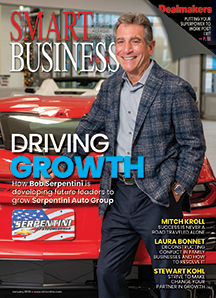Regional acceleration can be strengthened by collaborating with universities.
There are many examples of strong regional centers of innovation that create high growth in economic development through strong industry/university collaborations: Berkeley and Stanford, UNC, NC State and Duke, University of Texas, Carnegie Mellon and University of Pittsburgh, and The Ohio State University.
In Northeast Ohio we have a number of world-class universities and community colleges, and the NASA Glenn Research Center, and all have a senior-level officer for business engagement. We have a multitude of excellent companies, from leading multinationals to small and medium-sized companies, and a growing number of high-potential start-ups, many based on university innovations.
We have a strong alumni base from graduates working in these companies who can facilitate the collaboration and an established regional network of entrepreneurial service providers funded by Ohio and led by JumpStart, including Team NEO, MAGNET, Ohio Aerospace Institute and Bounce Innovation Hub. All of the ingredients are available if we can establish a productive collaboration process.
A recent example of new collaboration efforts is the Polymer Industry Cluster, an initiative led by the Greater Akron Chamber. The cluster recently brought together senior leadership from the regional polymer industry, regional universities and local government in a Connectivity Conference focused on collaboration opportunities around a Sustainable Polymer Framework. The conference was facilitated by an organizational development consultant from Research Triangle in North Carolina, catalyzed by the Burton D. Morgan Foundation and The University of Akron Experiential Learning Center.
Businesses should look to validate the hypothesis that increased collaboration with regional universities will accelerate regional innovation. This will take time and commitment, as well as a willingness to listen to stakeholders and potential collaborators.
As a first step, industry leaders should become familiar with the NSF I-Corps program, an immersive, entrepreneurial training program that facilitates the transformation of invention to impact. Its immersive seven-week experiential training program prepares scientists and engineers to extend their focus beyond the university laboratory, accelerating the economic and societal benefits of NSF-funded and other basic research projects that are ready to move to commercialization.
You can also learn more by participating in an I-Corps program in your local region, like the University of Akron’s I-Corps program (uakronuarf.com/i-corps), open to innovators in Ohio. Consider mentoring a team in an upcoming I-Corps cohort, or submit an innovative team from your organization to participate. The program is virtual, so there are no travel expenses.
Industry leaders should also consider interviewing universities as potential customers. It is important that decision-makers conduct these interviews, so they can hear needs first-hand and ask insightful follow-up questions. You’ll be amazed what you can learn as you engage in conversation about how a university can work with your business to increase collaboration.
The process of forming collaboration programs will not always be easy, and doing so will require trust and ability to deal with some uncertainty and even, potentially, some risk. To explore the possibilities, reach out for support to break the ice and help make contacts at universities. ●
Barry Rosenbaum is a Senior Fellow at University of Akron Research Foundation


